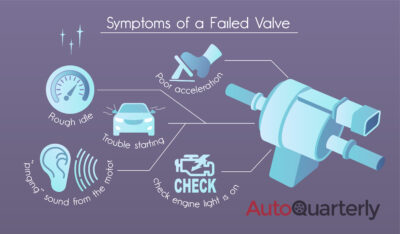Modern cars have really sophisticated emissions control systems. They use catalytic converters to clean up the exhaust gases, sensors that keep engines running at optimal efficiency, and a system of canisters and tubes that pulls fuel vapor out of the exhaust and puts it back into the engine.
That last system is the one that contains the charcoal canister, sometimes called an evaporative emission control canister and the canister purge valve. If your canister purge valve fails, it can cause various intermittent problems that can be difficult to track down.
In this article, we’ll look at the symptoms of a failed evap purge valve. We’ll also go over what that valve does and how you can check it. We’ll end with how you can replace it if need be.
Symptoms of a Failed Valve
A failed purge valve simply creates a vacuum leak into the intake manifold. Therefore, all of the symptoms of a vacuum leak are identical to the symptoms of a bad purge valve. These include:
- Rough idle
- Poor acceleration
- Trouble starting
- Occasional “pinging” sound from the motor
- The check engine light is on
Fault Codes and the Check Engine Light
Whenever your car’s computer experiences an issue, it creates a fault code. Think of fault codes like an error report. The way the computer gets your attention to tell you there is a fault code is by illuminating the check engine light. You can check the fault codes using an OBD2 scanner like one of the ones we recommend.
There are codes directly associated with the purge valve, like the P0443. However, because the symptoms are identical to a vacuum leak, you can also get various sensor errors instead. The car’s computer doesn’t know if the vacuum leak is caused by a bad gasket or a stuck valve. This can cause a lot of frustration as you replace the sensors the computer thinks are bad, only for none of them to actually be bad. Instead, it’s just a simple stuck purge valve.
Is It Dangerous to Drive With a Bad Purge Valve?
There is not very much danger in driving with a bad evap purge valve. It can cause parts inside your motor to wear out faster, but modern computers can easily compensate for minor leaks.
You will notice that your gas mileage, and therefore your bank account, will suffer. If the problem goes unfixed long enough, you can begin risking damage to the catalytic converter. Catalytic converters are very expensive to replace, so it’s best not to let the issue go on for too long, even though it’s not particularly dangerous.
Inspection Failures
The other thing to keep in mind is that if you live in a state that does inspections, your car will fail the inspection because of the fault code. The purge valve is linked to the emissions of the car. Emission issues are some of the automatic fail conditions in many states, so it is best to have the issue fixed prior to an inspection.
What the Canister Purge Valve Does
The charcoal canister purge valve, or evap purge valve, is nothing more than a small, vacuum or electronically actuated air valve that is attached to the back of the intake manifold. The other end of the valve usually has a hose that runs all the way back towards the gas tank and into the charcoal canister. That’s not always the case, many mid 90s cars have a charcoal canister in the engine bay, but most modern cars have the canister located near the back of the car.
The charcoal canister pulls unburned fuel out of the exhaust so that they don’t get released into the air. Instead, it diverts the vapors back into the motor through the canister valve. The motor then burns the fuel just as it would any other fuel injected into the motor. This keeps emissions low and helps improve the health of your motor.
Why Purge Valves Fail
Most purge valves are simple plastic bodies with a small solenoid that opens and closes a rubber flap. Carbon buildup or damage to the plastic body can cause the valve to stick open, which causes a permanent vacuum leak into your manifold.
It is more rare, but a purge valve can also fail when the car’s computer begins to send it the incorrect signals because of faulty wiring or malfunctioning code. Usually, if the computer is failing, you’ll have a variety of other issues in addition to the vacuum leak symptoms associated with a stuck purge valve.
How to Test a Purge Valve
The easiest way to test a purge valve is to feel for a vacuum. Start by removing the electrical connection to the valve if there is one, and then remove the hose going back to the canister. If you can, have a friend start the car while you make sure that nothing is dangling near any fans or belts. If you are working alone, you should tie hoses and connections up out of the way.
Then reach over the motor and press your finger against the open side of the purge valve. Be careful not to touch hot engine parts or get your finger stuck in a belt. Both those things can be very unpleasant.
Here’s a quick video that shows the process and explains a bit about the valves themselves.
Replacing a Purge Valve
If you have a bad valve, you have a few options. You can have a mechanic replace the part for you, or it’s a fairly simple procedure to replace it yourself.
Paying a Mechanic
You can expect to pay between $100 and $200 to have a mechanic replace a failed valve for you. The cost of the valve itself can vary greatly depending on the make and model of your car, and that’s the biggest variable. A good shop can perform the task in less than an hour, which means you can save money if you can find the part used or cheaper online.
Doing It Yourself
It’s fairly easy to replace a canister purge valve. They are serviceable parts and usually easy to find on top of a motor.
You will only need a few hand tools like screwdrivers or a basic wrench set. The way that the valve is attached varies greatly, so it’s best to just visually check before diving in.
The steps are as follows:
- Disconnect the negative battery cable from the battery
- Locate the purge valve
- Unplug any electrical connections to the valve while being careful not to break the connector
- Mark or label the hoses going into the valve
- Unplug the hoses
- Remove the valve. Sometimes they are held in with a couple bolts.
- Install the new valve
- Plug the hoses in being careful not to mix them up
- Plug the electrical connector back in
- Connect the negative battery cable
- Start the car and clear the DTC if necessary
Don’t Let Vacuum Leaks Ruin Your Day or the Earth
The earth is really important, and everything we can do to keep our car’s emissions systems working is good. It’s also important to keep your car healthy to promote your own mental health; a car that isn’t running well is frustrating. Hopefully, this guide can help you find the problem fast and fix it without any headaches.




